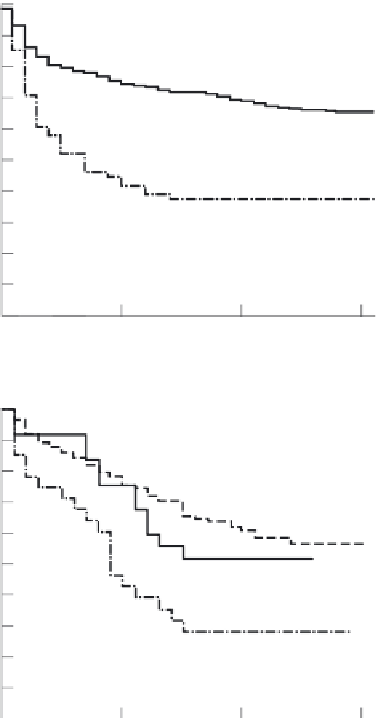Environmental Engineering Reference
In-Depth Information
Fig. 5.10
Effect of
inbreeding on
probability of survival
to 30 days of age of
pink pigeon nestlings
(a) in captivity and (b)
in the wild population.
Inbreeding is expressed
as an index derived
from known ancestry in
relation to 23 'founder'
individuals. The fewer
founders in a bird's
ancestry, the higher the
index of inbreeding.
Birds are grouped
into three classes -
non-inbred,
moderately inbred and
highly inbred. Only
highly inbred birds
show a powerful effect
of inbreeding. (After
Swinnerton et al.,
2004.)
(a)
1.0
Moderately inbred
0.8
Noninbred
0.6
Highly inbred
0.4
0.2
0
0
10
20
30
Survival time (days)
(b)
1.0
0.8
Moderately inbred
0.6
Noninbred
0.4
Highly inbred
0.2
0
0
10
20
30
Survival time (days)
This reintroduction success story has the added benefi t of providing a rare
quantifi cation of the value of avoiding inbreeding when managing endangered
populations.
5.5.3
Reintroduction
of a 'red list' plant -
the value of crossing
A rare variety of
Silene douglasii
(var.
oraria
)
is a white-fl owered perennial plant that
lives in coastal grassland but is now threatened throughout the state of Oregon,
USA, and endangered globally. During a reintroduction attempt in previously grazed
habitat within its historical range, the opportunity was taken to compare the success
of individuals that varied in terms of inbreeding. Over a 3-year period plants were
derived from seeds from self-pollinated fl owers (inbred, because both 'parents' are
the same plant) and cross-pollinated plants (outbred - different parents). A third
class of plants was 'open-pollinated' by insects, having been naturally pollinated
and without the experimental manipulation of forced self- or cross-pollination.
Progeny of the outbred, cross-pollinated fl owers show signifi cantly greater
survival than offspring of self-pollinated or open-pollinated fl owers. The outbred























Search WWH ::

Custom Search